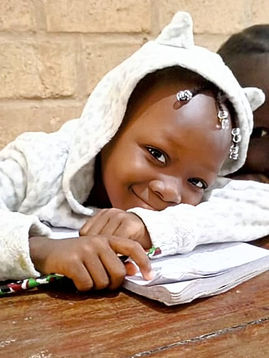

BABY BONUS BONANZA | EMPOWERING MUMS IN SIERRA LEONE
Discover how celebrating baby bonuses in Sierra Leone boosts vaccination rates and supports young families at this crucial time.
Mo Bangura
Oct 12


BAGS IN THE AIR! | CELEBRATING EDUCATION IN SIERRA LEONE
Find out far a €500 donation goes bringing hope and education to vulnerable kids living in the proud slum community of Moa Wharf, Sierra Leone.
Mo Bangura
Oct 3


JIMMY AND THE CASE OF THE BOOT POLISHED HAIR
Little Jimmy's in big trouble! Uncle Mo's worried he might have a skin thing going on but not to worry, according to Scout, Jimmy just...
Mo Bangura
Sep 13


BACK TO SCHOOL IN SIERRA LEONE
Despite the misty moisty early morning there's lots of smiles as the kids join thousands of other students accross Sierra Leone heading...
Mo Bangura
Sep 8


TWO BRAIDS FOR SISTER SARAH
As the kids summer holiday in beautiful Sanda Magbolontor on the Hope Sakuma farm draws to a close Scout and Kye really really don't want...
Mo Bangura
Aug 30


SIERRA LEONE SUMMER SCHOOL: HEADS DOWN FOR EXAM WEEK
Join the kids on an inspiring journey as it's exam week at Hope's Free Summer School, empowering local children with education and hope
Mo Bangura
Aug 28


KIDS HAVE FUN DOWN ON THE FARM
The kids looking smart in their Hope Sakuma t-shirts learn they've got to head back home to Mama Mayila's Cradle only they really want to...
Mo Bangura
Aug 25


SIERRA LEONE SUMMER SCHOOL: GIRLS WIN HANDS-DOWN
Join the kids on an inspiring journey as Hope's Free Summer School returns in Sierra Leone, empowering local children with education and hope
Mo Bangura
Aug 22


DANCE OFF DOWN ON THE FARM
As well as running riot and rings round poor uncle Mo, the kids find time to help out the Hope Sakuma team clearing, weeding and dancing!...
Mo Bangura
Aug 17


SIERRA LEONE SUMMER SCHOOL: LOST IN LEARNING
Join the kids on an inspiring journey as Hope's Free Summer School returns in Sierra Leone, empowering local children with education and hope
Tim Sherry
Aug 10


WE'RE ALL GOING ON OUR SUMMER HOLIDAYS!
Uncle Mo went to Sanda and took… 12 children, 11 rubbers for water, 10 roll up mattresses, 9 suitcases and just like my Aunt went to...
Mo Bangura
Aug 9


DESTINY AND THE CASE OF THE CRYING SKIRT
Ever known a child who's grown out of their favourite clothes but just wants to keep on wearing them? Well, we know just such a child,...
Mo Bangura
Aug 5


HOPES FREE SUMMER SCHOOL RETURNS
Join the kids on an inspiring journey as Hope's Free Summer School returns in Sierra Leone, empowering local children with education and hope
Mo Bangura
Aug 3


RAINY SEASON BOUNTY FOR MOA WHARF KIDS
Find out far a €400 donation goes bringing hope to vulnerable kids living in the proud slum community of Moa Wharf, Sierra Leone.
Mo Bangura
Aug 3


LEO'S GREAT BIG GRADUATION DAY
Rising Academy's jam-packed graduation event held at the District Council offices where students, caregivers and teachers all gathered to...
Mo Bangura
Jul 20


A-WEEDING WE SHALL GO!
It's the boys turn to step up and weed the Hope Sakuma rice - there's a lot of rice so a lot of weeding to be done - but it’s the Temne...
Mo Bangura
Jul 15


SIERRA LEONE SCHOOL'S OUT FOR THE SUMMER
The Hope kids wave goodbye to the end of the school year and say hello to their summer hols! Waving goodbye as they head off this morning...
Mo Bangura
Jul 13


BABY BONUS SMILES: EMPOWERING MOTHERS IN SIERRA LEONE
Discover how celebrating baby bonuses in Sierra Leone boosts vaccination rates and supports young families at this crucial time.
Mo Bangura
Jul 6


ALL THE TEMNE LADIES SING OUT
The Ladies step up and sing out to help on the Hope Sakuma farm spending two days weeding the Bangura brothers boliland rice, looking...
Mo Bangura
Jul 4


GRADUATION CELEBRATIONS IN SIERRA LEONE
A ram-packed Spring Water Community Academy, filled with students and parents and well-wishers from the Mabron community, gathered...
Mo Bangura
Jun 29


REPORTING BACK, LOOKING FORWARD
Discover the impact of our non-profit organization in Sierra Leone, bringing hope to over 500 vulnerable children.
Mo Bangura
Jun 22


CELEBRATING AFRICAN CHILD DAY IN SIERRA LEONE
The kids at Mama Mayila's Cradle celebrate international day of the African Child in style donning outfits in a rainbow of African...
Mo Bangura
Jun 15


PERFECT PINNEAPPLES: FROM FARM-TO-FINGERS
The kids at Mama Mayila's Cradle are filled with excitement as they gather around to celebrate a special delivery of pineapples, freshly...
Mo Bangura
Jun 8


CELEBRATING BABY BONUSES IN SIERRA LEONE
Discover how celebrating baby bonuses in Sierra Leone boosts vaccination rates and supports young families at this crucial time.
Mo Bangura
May 31


EXCITING FIELD TRIP: LEARNING ABOUT THE ENVIRONMENT
The students at Abierich Academy were buzzing with excitement as they embarked on their first official field trip, a highly anticipated...
Mo Bangura
May 22


WARM WELCOME FOR THE HARROWERS RETURN
With a traditional Temne song the Hope Sakuma team welcome back Momoh, Abdulai and their trusty Ford tractor to the farm trailering the...
Mo Bangura
May 18


HEATED DEBATE: FAITH HONOURS TEACHERS
Join the kids as they enjoy a heated debate ‘teacher or doctor - which is best?’ Speaking up for teachers, Destiny and team while Ollie...
Mo Bangura
May 6


FARE THEE WELL TRUSTY TRACTOR!
With a farewell song and some very enthusiastic pan-banging we bid adieu to Abulai, Lincoln and their trusty tractor after a solid 8 days...
Mo Bangura
May 1


HAPPY BIRTHDAY MAMA SALONE!
On the shores of beautiful Whale Bay with gratitude and love to Sierra Leoneans across the World a happy and delightful 64th anniversary...
Mo Bangura
Apr 27


SIERRA LEONE TRACTOR LOVE
Some very enthusiastic cheers and a little dance rounds off a week's work well done as the Hope Sakuma team show Abdulai, Lincoln and...
Mo Bangura
Apr 25


HOPE SAKUMA: JOYOUS WELCOME FOR FIRST TRACTOR
A joyful reception for the farms' first tractor as it hoves into view, arriving to plough land not farmed since before the civil war. Pa...
Mo Bangura
Apr 19


SATURDAYS' SALUTORY SOCCER LESSON
The kids, taking a sure-fire route to soccer success, hit upon the bright idea of hiring their footballing talent in rather than the hard...
Mo Bangura
Apr 18


REST IN PERFECT PEACE AUNTY ROSE
What seemed like the whole of Freetown came to mourn the passing of Aunty Rose Tiafoe, Thursday, resting perfectly in peace at the grand...
Mo Bangura
Apr 17


SPORTING GOLD: LITTLE LIAM TRIUMPHS BIG
John Obey community sports ground was a-buzz with excitement today as caregivers and well-wishers followed the grand sporting pararde...
Mo Bangura
Apr 12


HOPE SAKUMA: A-MULCHING WE SHALL GO!
The Hope Sakuma team mulch the remaining vegetable beds with rice straw to supress weeds and retain moisture in the soil after they water...
Mo Bangura
Apr 8


HOPE SAKUMA: JICA COMES UP TRUMPS TRACKING DOWN TRACTOR
Mohamed comes up trumps tracking down the tractor, visiting Menteh on his mission and the brothers Bangura become mighty excited at the...
Mo Bangura
Apr 4


CELEBRATING SIERRA LEONE CHILDRENS' BOOK DAY
Join the Hope kids celebrating Children's Book Day in Sierra Leone, eager to deep dive into their favourite books
Mo Bangura
Apr 1


HOPE SAKUMA: 108 FINISH!
The hard-working Hope Sakuma team celebrate their 108th row of vegetable and cassava; marking out more nice neat rows ready for planting,...
Mo Bangura
Mar 30


A HEATWARMING RETURN
A heart-warming and heartening visit, as Harper and Ami, Isa and Elle make a welcome return to their roots and Mama Salone with their two...
Mo Bangura
Mar 27


HOPE SAKUMA: GROWING FOR SEED
The Hope Sakuma team take a well-earned break, resting int he shade as Mohamed Jica, Morlai, Pa Aruna and new recruit, Abdul set about...
Mo Bangura
Mar 23


A-BARBERING WE SHALL GO!
Leo expertly barbers all the boys, showcasing his barbering skills while Sophie deftly teases and twists the girls hair into beautiful...
Mo Bangura
Mar 22


HOPE SAKUMA: JICA JOINS THE TEAM
Morlai and Pa Aruna welcome old friend Mohamed Jica to the Hope Sakuma. Long-time followers will recall the farms’ early days when...
Tim Sherry
Mar 12


WHEN WE'RE CLEANING WINDOWS!
The official start of spring heralds much-anticipated time for spring cleaning, a seasonal ritual that many families embrace with...
Mo Bangura
Mar 9


SATURDAY SOCCER IN SIERRA LEONE
The boys head down to grassfield for a quick game of 4-a-side soccer in sporting outfits of orange and yellow enjoying the chance to...
Mo Bangura
Mar 1


GOING FOR GOLD: SIXTH SPRINGWATER SPORTS MEET
The sixth annual inter-house sports day took place today at Springwater Community Academy, located in the vibrant heart of Mabron. This...
Mo Bangura
Feb 22


KNOWLEDGE IS LIGHT
Leo steps up to join Alex teaching the kids at Mama Mayila's Cradle, reprising his summer school success and giving a Math class of times...
Mo Bangura
Feb 12


HOPE SAKUMA: GRAND DAY A-PLANTING!
Hope Sakumas' grand pepper planting gets underway carefully transplanting nursed seedlings but not before Morlai stops to collect...
Mo Bangura
Feb 3


GOING FOR GOLD: RISINGS' SPORTS DAY
An opening ceremony with a grand parade of students in their house colours gets everyone in the sporty mood for Rising Academy's two day...
Mo Bangura
Feb 2


HOPE SAKUMA: PADDIES INTO PEPPER BEDS
Hope Sakumas’ new interim farm coordinator, Morlai, starts his tenure carefully measuring and marking out nice straight vegetable beds...
Mo Bangura
Jan 22


HOPE'S BIG BOARD MEET
Mama Mayila and all the kids extend a warm welcome to the esteemed members of the Hope Board as they gather for the first meet of 2025,...
Mo Bangura
Jan 19








































































Comments